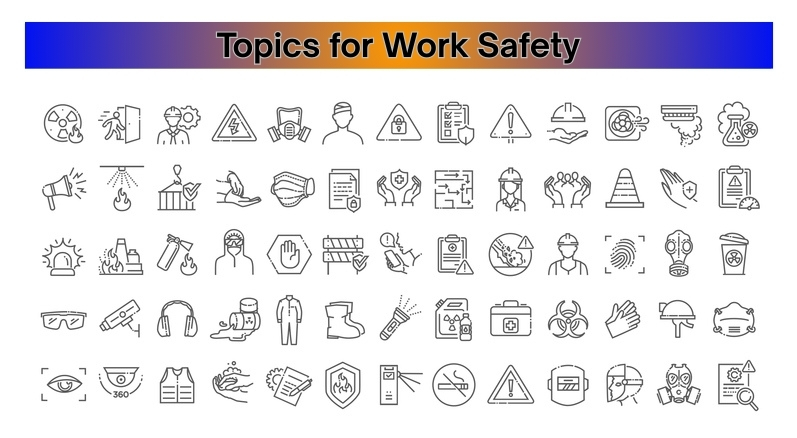OSHA history has a special place in ensuring the introduction of workplace safety for the benefit of employees and the reduction of ever-increasing workplace accidents.
When was OSHA Created: 1970s the Founding and Foundation

Established in 1970 by the Occupational Safety and Health Act, OSHA commenced operations on April 28, 1971. Throughout its inaugural decade, OSHA was established to ensure workplace safety, issuing pioneering standards for hazardous substances like asbestos, lead, and cotton dust. Crucial programs such as the OSHA Training Institute and whistleblower protections were also instituted.
The 1980s: Expansion and Empowerment
The U.S. Supreme Court’s affirmation of workers’ rights to refuse unsafe tasks marked a pivotal moment in the 1980s. OSHA introduced standards granting workers the right to knowledge about chemical exposure and mandated employers to furnish medical and exposure records. Innovations like the Voluntary Protection Programs and heightened protections for workers in various sectors underscored the agency’s commitment to worker empowerment and safety.
1990s: Strengthening Protections
The 1990s witnessed OSHA’s issuance of the Process Safety Management standard and the fortification of worker protections against falls, bloodborne pathogens, toxic substances, and confined spaces. The establishment of OSHA Education Centers expanded safety training opportunities, while collaborative efforts with employers flourished through the Strategic Partnership Program.
The 2000s: Responding to Crisis
Amid unprecedented challenges posed by events like the 9/11 attacks and Hurricane Katrina, OSHA mobilized alongside federal, state, and local partners to safeguard recovery workers. Notable standards aimed at protecting construction workers and preventing exposure to hazardous materials continued to enhance workplace safety.
2010s +: Addressing Contemporary Challenges
OSHA’s response to crises expanded into the 2010s, with efforts to protect workers responding to disasters like the Deepwater Horizon explosion and oil spill. The agency issued vital standards concerning silica dust, cranes, confined spaces, and chemical classification and labeling. Initiatives like the fall prevention campaign targeted prevalent risks in industries like construction, while the historic response to the COVID-19 pandemic underscored OSHA’s adaptability and commitment to worker well-being.
2020 and Beyond: Meeting the Moment
As the new decade dawned, OSHA confronted the unparalleled challenge posed by the COVID-19 pandemic. Swift action, outreach, education, and collaboration with authorities were central to the agency’s response. Even amid these evolving health crises, OSHA remains steadfast in its mission to protect workers’ rights to a safe and healthy workplace.
As OSHA continues its vital work, it calls on all stakeholders to renew their commitment to workplace safety and health, affirming that safeguarding workers’ well-being is an essential and ongoing endeavor.
Who Founded OSHA?
OSHA (Occupational Safety and Health Administration) was not formed by one person. The Occupational Safety and Health Act of 1970 was signed into law by President Richard Nixon. The Act was enacted in response to growing public concern about workplace safety and health in the United States.
Who Created OSHA?
President Richard Nixon signed the Occupational Safety and Health Act of 1970, which established the Occupational Safety and Health Administration (OSHA). While not authored by a single person, the Act was the result of collaboration and efforts by a variety of parties, including lawmakers, labor unions, businesses, and advocacy groups, to address workplace safety and health concerns in the United States.
Why was OSHA Created?
When was OSHA created? The creation of OSHA was in 1970. It was a direct response to escalating worries surrounding workplace injuries, illnesses, and fatalities in the United States. The surge in workplace-related human and economic costs underscored the urgent need for standardized safety measures across industries.
Establishment of OSHA: Ensuring Safe Working Conditions

President Nixon signed the Occupational Safety and Health Act into law, designating OSHA as the primary federal agency responsible for safeguarding safe and healthy working conditions for all American workers. OSHA’s significance lies in its pivotal role in protecting workers from potential hazards and risks in the workplace.
OSHA’s Mandate: Setting Standards and Enforcing Compliance
OSHA fulfills its mandate by setting and enforcing safety standards, conducting inspections, and providing training, outreach, education, and compliance assistance. Through these efforts, OSHA assists employers in identifying and mitigating potential hazards before they harm workers.
Addressing Pre-OSHA Conditions: Lack of Federal Regulations
Before OSHA’s establishment, there were no federal regulations governing workplace safety. Many employers neglected to implement adequate safety measures, leaving workers vulnerable to hazards without legal protections or resources to ensure their safety. OSHA’s creation was imperative to address these deficiencies and establish a comprehensive framework for workplace safety.
OSHA’s Impact: Improving Workplace Safety
Since its inception in 1971, OSHA has played a crucial role in enhancing workplace safety and reducing injuries and fatalities. The agency has contributed to a significant decrease in workplace fatalities by 66%, empowering workers to report safety violations and participate in safety program development.
Benefits of OSHA Compliance: Creating Safer Work Environments
Compliance with OSHA regulations not only protects workers but also benefits employers by avoiding costly fines and penalties. Prioritizing workplace safety and adhering to OSHA standards fosters a safer and healthier work environment, leading to enhanced productivity, morale, and overall organizational well-being.
OSHA’s establishment was a pivotal moment in American labor history, addressing critical gaps in workplace safety regulation and enforcement. Through its ongoing efforts, OSHA continues to uphold its mission of ensuring safe and healthy working conditions for all, driving positive outcomes for workers, employers, and society as a whole.
Why is OSHA Training Important?

Enhanced Safety Awareness: OSHA education and training raise awareness among workers and managers about workplace hazards and necessary controls, minimizing accident risks.
Essential Knowledge and Skills: Training equips employees with skills to perform tasks safely, identify hazards, and take preventive measures.
Compliance and Effectiveness: Safety manager training ensures compliance with safety regulations, improves managerial effectiveness, and boosts productivity and product quality.
Reduced Incidents: Training helps identify and prevent hazards, reducing workplace injuries, illnesses, and fatalities, benefiting workers, families, and employers.
How long has OSHA been around: OSHA has been around for over five decades, established in 1970 to ensure safe and healthy working conditions.
Future Of OSHA

The future of OSHA is intertwined with technological advancements and the evolving landscape of occupational health and safety. As technology continues to progress, OSHA will likely incorporate more advanced tools and methodologies to enhance workplace safety.
Integration of Technology: OSHA will increasingly leverage technology to gather and analyze data for enhanced insights into workplace hazards and risks. This includes the use of artificial intelligence, machine learning, and real-time monitoring systems to predict and prevent incidents before they occur.
Data-driven Approach: With the ability to capture and analyze vast amounts of data, OSHA will adopt a more data-driven approach to safety management. This includes utilizing data analytics to identify trends, prioritize interventions, and allocate resources effectively.
Predictive Safety: The future of OSHA will involve predictive safety measures, where advanced analytics and predictive modeling will help anticipate potential hazards and mitigate risks proactively. By leveraging predictive analytics, OSHA can intervene before incidents occur, leading to safer workplaces and reduced injuries and fatalities.
Embracing Innovation: OSHA will embrace innovation in safety technologies, encouraging the development and adoption of new tools and solutions to address emerging risks and challenges in the workplace. This may include wearable technology, virtual reality training, and robotics for hazardous tasks.
Collaborative Efforts: OSHA will continue to collaborate with industry stakeholders, researchers, and technology providers to drive innovation and best practices in occupational health and safety. This collaborative approach will ensure that OSHA remains at the forefront of safety advancements and adapts to the changing needs of the workforce.
Concluding lines:
The history of OSHA reflects the ongoing struggle for worker health and safety. From its humble beginnings as a result of the Industrial Revolution to its current function as a protector of workers’ rights, OSHA has had a significant impact on the landscape of American labor relations. As we reflect on the agency’s 53-year history, we are reminded of the continual need to protect workers from harm and uphold their fundamental right to a safe workplace. Despite increasing difficulties and uncertainty, OSHA remains committed to enhancing workplace safety and preserving labor dignity.







